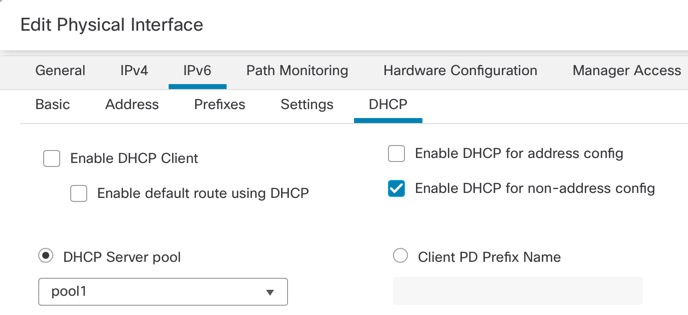Enable the DHCPv6 Stateless Server
For clients that use StateLess Address Auto Configuration (SLAAC) in conjunction with the Prefix Delegation feature (Enable the IPv6 Prefix Delegation Client), you can configure the Firewall Threat Defense to provide information such as the DNS server or domain name when they send Information Request (IR) packets to the Firewall Threat Defense. The Firewall Threat Defense only accepts IR packets and does not assign addresses to the clients. You will configure the client to generate its own IPv6 address by enabling IPv6 autoconfiguration on the client. Enabling stateless autoconfiguration on a client configures IPv6 addresses based on prefixes received in Router Advertisement messages; in other words, based on the prefix that the Firewall Threat Defense received using Prefix Delegation.
This feature is only supported in routed mode. This feature is not supported in clustering or High Availability.
Before you begin
Add a DHCP IPv6 Pool object. See Create the DHCP IPv6 Pool. This object defines the server parameters included in the IR messages.
Procedure
Step 1 | Select and click Edit ( |
Step 2 | Click Edit ( |
Step 3 | Click the IPv6 page, and then click DHCP. |
Step 4 | Click DHCP Server Pool, and choose the object you created earlier. 
|
Step 5 | Check Enable DHCP for non-address config to inform SLAAC clients about the DHCPv6 server. This flag informs IPv6 autoconfiguration clients that they should use DHCPv6 to obtain additional information from DHCPv6, such as the DNS server address. |
Step 6 | Click OK. |
Step 7 | Click Save. You can now go to and deploy the policy to assigned devices. The changes are not active until you deploy them. |
